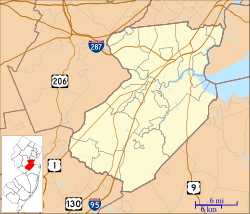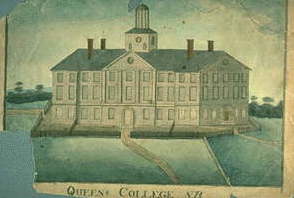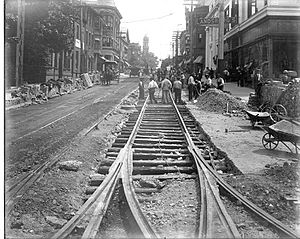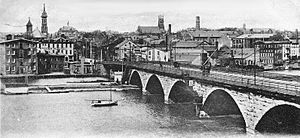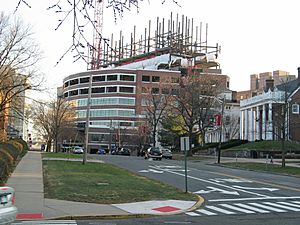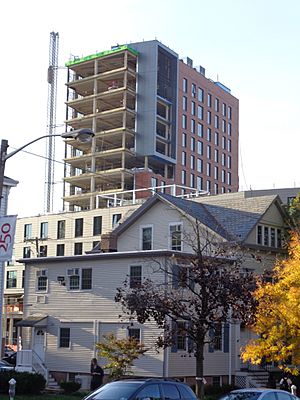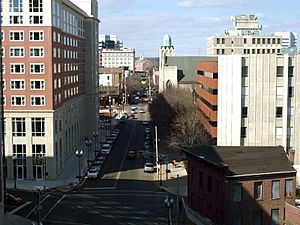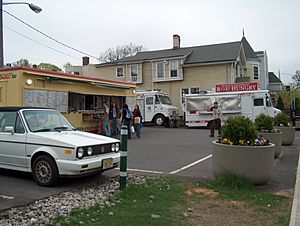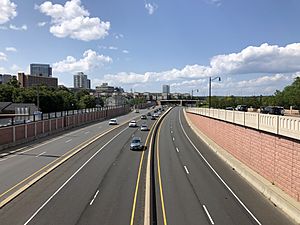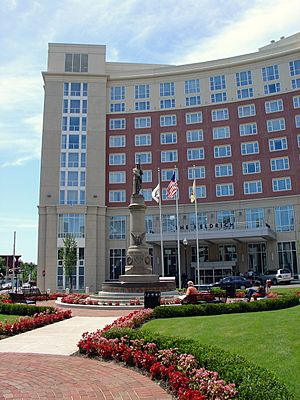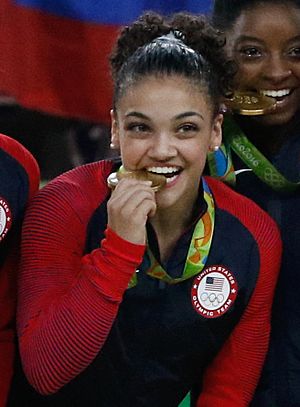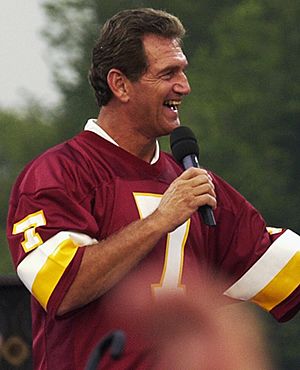New Brunswick, New Jersey facts for kids
Quick facts for kids
New Brunswick, New Jersey
|
|
|---|---|
|
City
|
|
| City of New Brunswick | |
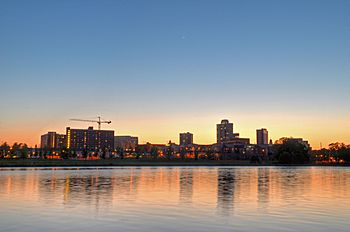
The skyline of New Brunswick seen at sunset along the Raritan River, the longest river solely within New Jersey
|
|
| Nickname(s):
Hub City, Healthcare City
|
|
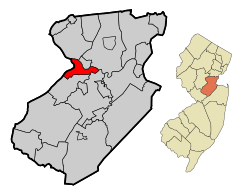
Location within Middlesex County
|
|
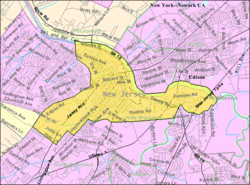
Census Bureau map of New Brunswick, New Jersey
|
|
| Country | |
| State | |
| County | Middlesex |
| Established | December 30, 1730 |
| Incorporated | September 1, 1784 |
| Named for | Braunschweig, Germany, or King George II of Great Britain |
| Government | |
| • Type | Faulkner Act (mayor–council) |
| • Body | City Council |
| Area | |
| • Total | 5.75 sq mi (14.90 km2) |
| • Land | 5.23 sq mi (13.55 km2) |
| • Water | 0.52 sq mi (1.35 km2) 9.06% |
| Area rank | 264th of 565 in state 14th of 25 in county |
| Elevation | 62 ft (19 m) |
| Population | |
| • Total | 55,266 |
| • Rank | 27th of 566 in state 5th of 25 in county |
| • Density | 10,556.4/sq mi (4,075.8/km2) |
| • Density rank | 689th in country (as of 2019) 34th of 566 in state 2nd of 25 in county |
| Time zone | UTC−05:00 (Eastern (EST)) |
| • Summer (DST) | UTC−04:00 (Eastern (EDT)) |
| ZIP Codes |
08901–08906, 08933, 08989
|
| Area code(s) | 732/848 and 908 |
| FIPS code | 3402351210 |
| GNIS feature ID | 0885318 |
| New Brunswick is the county seat for Middlesex County. | |
If I had to fall I wish it had been on the sidewalks of New York, not the sidewalks of New Brunswick, N.J.
New Brunswick is a city in Middlesex County, New Jersey, United States. The city is the county seat of Middlesex County, and is the home of Rutgers University. The city is both a regional commercial hub for the Central New Jersey region and a prominent and growing commuter town for residents commuting to New York City within the New York metropolitan area. New Brunswick is on the Northeast Corridor rail line, 27 miles (43 km) southwest of Manhattan. The city is located on the southern banks of the Raritan River in the Raritan Valley region.
For 2020, New Brunswick had a population of 55,266, representing a 0.2% increase from the 55,181 people enumerated at the 2010 United States Census, which in turn had reflected an increase of 6,608 (+13.6%) from the 48,573 counted in the 2000 Census. The Census Bureau's Population Estimates Program calculated that the city's population was 55,676 in 2019, ranking the city the 689th-most-populous in the country. Due to the concentration of medical facilities in the area, including Robert Wood Johnson University Hospital and Saint Peter's University Hospital, as well as Rutgers, The State University of New Jersey's Robert Wood Johnson Medical School, New Brunswick is known as both the Hub City and the Healthcare City. The corporate headquarters and production facilities of several global pharmaceutical companies are situated in the city, including Johnson & Johnson and Bristol Myers Squibb. New Brunswick has evolved into a major center for the sciences, arts, and cultural activities, bringing gentrification to the city.
New Brunswick is noted for its ethnic diversity. At one time, one quarter of the Hungarian population of New Jersey resided in the city and in the 1930s one out of three city residents was Hungarian. The Hungarian community continues as a cohesive community, with the 3,200 Hungarian residents accounting for 8% of the population of New Brunswick in 1992. Growing Asian and Hispanic communities have developed around French Street near Robert Wood Johnson University Hospital.
Contents
History
Origins of the name
It was first inhabited by the Lenape Native Americans. The first European settlement at the site of New Brunswick was made in 1681. The settlement here was called Prigmore's Swamp (1681–1697), then known as Inian's Ferry (1691–1714). In 1714, the settlement was given the name New Brunswick, after the city of Braunschweig (called Brunswick in the Low German language), in state of Lower Saxony, in Germany. Braunschweig was an influential and powerful city in the Hanseatic League, later in the Holy Roman Empire, and was an administrative seat for the Duchy (and later Principality) of Hanover. Shortly after the first settlement of New Brunswick in colonial New Jersey, George, Duke of Brunswick-Lüneburg, and Elector of Hanover, of the House of Hanover (also known as the House of Brunswick), became King George I of Great Britain (1660–1727). Alternatively, the city gets its name from King George II of Great Britain, the Duke of Brunswick-Lüneburg.
During the Colonial and Early American periods
Centrally located between New York City and Philadelphia along an early thoroughfare known as the King's Highway and situated along the Raritan River, New Brunswick became an important hub for Colonial travelers and traders. New Brunswick was incorporated as a town in 1736 and chartered as a city in 1784. It was incorporated into a town in 1798 as part of the Township Act of 1798. It was occupied by the British in the winter of 1776–1777 during the Revolutionary War.
The Declaration of Independence received one of its first public readings, by Col. John Neilson, in New Brunswick on July 9, 1776, in the days following its promulgation by the Continental Congress.
The Trustees of Queen's College (now Rutgers University), founded in 1766, voted to locate the young college in New Brunswick, selecting the city over Hackensack, in Bergen County, New Jersey. Classes began in 1771 with one instructor, one sophomore, Matthew Leydt, and several freshmen at a tavern called "The Sign of the Red Lion" on the corner of Albany and Neilson Streets (now the grounds of the Johnson & Johnson corporate headquarters). Classes were held through the American Revolution in various taverns and boarding houses, and at a building known as College Hall on George Street, until Old Queens was erected in 1808. It remains the oldest building on the Rutgers University campus. The Queen's College Grammar School (now Rutgers Preparatory School) was established also in 1766, and shared facilities with the College until 1830, when it located in a building (now known as Alexander Johnston Hall) across College Avenue from Old Queens. After Rutgers University became the state university of New Jersey in 1945, the Trustees of Rutgers divested itself of Rutgers Preparatory School, which relocated in 1957 to an estate purchased from the Colgate-Palmolive Company in Franklin Township in neighboring Somerset County.
The New Brunswick Theological Seminary, founded in 1784 in New York, moved to New Brunswick in 1810, sharing its quarters with the fledgling Queen's College. (Queen's closed from 1810 to 1825 due to financial problems, and reopened in 1825 as Rutgers College.) The Seminary, due to overcrowding and differences over the mission of Rutgers College as a secular institution, moved to tract of land covering 7 acres (2.8 ha) located less than one-half mile (800 m) west, which it still occupies, although the land is now in the middle of Rutgers University's College Avenue campus.
New Brunswick was formed by Royal charter on December 30, 1730, within other townships in Middlesex and Somerset counties and was reformed by Royal charter with the same boundaries on February 12, 1763, at which time it was divided into north and south wards. New Brunswick was incorporated as a city by an act of the New Jersey Legislature on September 1, 1784.
African American community
The existence of an African American community dates back to the late 18th century, with the 1810 United States Census listing 53 free Blacks and 164 slaves. The city's Mount Zion African Methodist Episcopal Church, located at 39 Morris Street, was originally established in 1825 at 25 Division Street, making it one of the oldest in New Jersey.
Hungarian community
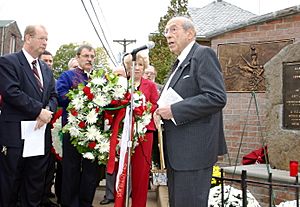
New Brunswick began attracting a Hungarian immigrant population around the turn of the 20th century. Hungarians were primarily attracted to the city by employment at Johnson & Johnson factories located in the city. Hungarians settled mainly in what today is the Fifth Ward.
The immigrant population grew until the end of the early century immigration boom. During the Cold War, the community was revitalized by the decision to house refugees from the failed 1956 Hungarian Revolution at Camp Kilmer, in nearby Edison. Even though the Hungarian population has been largely supplanted by newer immigrants, there continues to be a Hungarian Festival in the city held on Somerset Street on the first Saturday of June each year. Many Hungarian institutions set up by the community remain and active in the neighborhood, including: Magyar Reformed Church, Ascension Lutheran Church, St. Ladislaus Roman Catholic Church, St. Joseph Byzantine Catholic Church, Hungarian American Athletic Club, Aprokfalva Montessori Preschool, Széchenyi Hungarian Community School & Kindergarten, Teleki Pál Scout Home, Hungarian American Foundation, Vers Hangja, Hungarian Poetry Group, Bolyai Lecture Series on Arts and Sciences, Hungarian Alumni Association, Hungarian Radio Program, Hungarian Civic Association, Committee of Hungarian Churches and Organizations of New Brunswick, and Csűrdöngölő Folk Dance Ensemble.
Several landmarks in the city also testify to its Hungarian heritage. There is a street and a recreation park named after Lajos Kossuth, the famous leader of the Hungarian Revolution of 1848. The corner of Somerset Street and Plum Street is named Mindszenty Square where the first ever statue of Cardinal Joseph Mindszenty was erected. A stone memorial to the victims of the 1956 Hungarian Revolution also stands nearby.
Latino community
About 50% of New Brunswick's population is self-identified as Hispanic, the 14th highest percentage among municipalities in New Jersey. Since the 1960s, many of the new residents of New Brunswick have come from Latin America. Many citizens moved from Puerto Rico in the 1970s. In the 1980s, many immigrated from the Dominican Republic, and still later from Guatemala, Honduras, Ecuador and Mexico.
Demolition, revitalization and redevelopment
New Brunswick contains a number of examples of urban renewal in the United States. In the 1960s-1970s, the downtown area became blighted as middle class residents moved to newer suburbs surrounding the city, an example of the phenomenon known as "white flight." Beginning in 1975, Rutgers University, Johnson & Johnson and the local government collaborated through the New Jersey Economic Development Authority to form the New Brunswick Development Company (DevCo), with the goal of revitalizing the city center and redeveloping neighborhoods considered to be blighted and dangerous (via demolition of existing buildings and construction of new ones). Johnson & Johnson decided to remain in New Brunswick and built a new world headquarters building in the area between Albany Street, Amtrak's Northeast Corridor, Route 18, and George Street, requiring many old buildings and historic roads to be removed. The Hiram Market area, a historic district that by the 1970s had become a mostly Puerto Rican and Dominican-American neighborhood, was demolished to build a Hyatt hotel and conference center, and upscale housing. Johnson & Johnson guaranteed Hyatt Hotels' investment as they were wary of building an upscale hotel in a run-down area.
The redevelopment process has been controversial. Devco, the hospitals, and the city government continue to draw ire from both historic preservationists, those opposing gentrification and those concerned with eminent domain abuses and tax abatements for developers.
New Brunswick is one of nine cities in New Jersey designated as eligible for Urban Transit Hub Tax Credits by the state's Economic Development Authority. Developers who invest a minimum of $50 million within a half-mile of a train station are eligible for pro-rated tax credit.
The Gateway tower, a 22-story redevelopment project next to the train station, was completed in 2012. The structure consists of apartments and condominiums (named "The Vue") built above a multi-story parking structure with a bridge connecting it to the station. Boraie Development, a real estate development firm based in New Brunswick, has developed projects using the incentive.
Geography
According to the United States Census Bureau, the city had a total area of 5.789 square miles (14.995 km2), including 5.227 square miles (13.539 km2) of land and 0.562 square miles (1.456 km2) of water (9.71%). New Brunswick is in Raritan Valley (a line of cities in central New Jersey). New Brunswick is on the south side of Raritan Valley along with Piscataway Township, Highland Park, Edison Township, and Franklin Township (Somerset County). New Brunswick lies southwest of Newark and New York City and northeast of Trenton and Philadelphia.
New Brunswick is bordered by Piscataway, Highland Park and Edison across the Raritan River to the north by way of the Donald and Morris Goodkind Bridges, and also by North Brunswick Township to the southwest, East Brunswick Township to the southeast, and Franklin Township.
While the city does not hold elections based on a ward system it has been so divided. There are several neighborhoods in the city, which include the Fifth Ward, Feaster Park, Lincoln Park, Raritan Gardens, and Edgebrook-Westons Mills.
Climate
New Brunswick has a humid subtropical climate (Köppen climate classification Cfa) typical to New Jersey, characterized by humid, hot summers and mild winters with moderate to considerable rainfall throughout the year. There is no marked wet or dry season.
| Climate data for New Brunswick, New Jersey | |||||||||||||
|---|---|---|---|---|---|---|---|---|---|---|---|---|---|
| Month | Jan | Feb | Mar | Apr | May | Jun | Jul | Aug | Sep | Oct | Nov | Dec | Year |
| Average high °F (°C) | 39.2 (4.0) |
42.4 (5.8) |
50.5 (10.3) |
61.7 (16.5) |
71.7 (22.1) |
80.8 (27.1) |
85.6 (29.8) |
83.9 (28.8) |
77.3 (25.2) |
66.0 (18.9) |
55.3 (12.9) |
44.1 (6.7) |
63.2 (17.3) |
| Average low °F (°C) | 21.7 (−5.7) |
23.6 (−4.7) |
30.8 (−0.7) |
40.0 (4.4) |
49.5 (9.7) |
59.4 (15.2) |
64.5 (18.1) |
63.1 (17.3) |
55.1 (12.8) |
43.0 (6.1) |
35.3 (1.8) |
26.7 (−2.9) |
42.7 (5.9) |
| Average precipitation inches (mm) | 3.62 (92) |
2.87 (73) |
4.20 (107) |
4.21 (107) |
4.18 (106) |
4.39 (112) |
5.08 (129) |
4.15 (105) |
4.45 (113) |
3.80 (97) |
3.83 (97) |
4.06 (103) |
48.83 (1,240) |
| Average snowfall inches (cm) | 8.8 (22) |
9.2 (23) |
4.2 (11) |
.9 (2.3) |
0 (0) |
0 (0) |
0 (0) |
0 (0) |
0 (0) |
.1 (0.25) |
.5 (1.3) |
5.3 (13) |
29.0 (74) |
| Average precipitation days | 10.7 | 9.2 | 10.5 | 11.8 | 12.2 | 11.2 | 10.4 | 9.3 | 8.7 | 8.9 | 9.5 | 9.8 | 122.2 |
| Average snowy days | 4.8 | 3.8 | 2.3 | .4 | 0 | 0 | 0 | 0 | 0 | 0 | .3 | 2.2 | 13.8 |
| Source: NOAA | |||||||||||||
Demographics
| Historical population | |||
|---|---|---|---|
| Census | Pop. | %± | |
| 1840 | 5,866 | — | |
| 1850 | 10,019 | 70.8% | |
| 1860 | 11,256 | 12.3% | |
| 1870 | 15,058 | 33.8% | |
| 1880 | 17,166 | 14.0% | |
| 1890 | 18,603 | 8.4% | |
| 1900 | 20,005 | 7.5% | |
| 1910 | 23,388 | 16.9% | |
| 1920 | 32,779 | 40.2% | |
| 1930 | 34,555 | 5.4% | |
| 1940 | 33,180 | −4.0% | |
| 1950 | 38,811 | 17.0% | |
| 1960 | 40,139 | 3.4% | |
| 1970 | 41,885 | 4.3% | |
| 1980 | 41,442 | −1.1% | |
| 1990 | 41,711 | 0.6% | |
| 2000 | 48,573 | 16.5% | |
| 2010 | 55,181 | 13.6% | |
| 2020 | 55,266 | 0.2% | |
| Population sources: 1860–1920 1840–1890 1850–1870 1850 1870 1880–1890 1890–1910 1860–1930 1930–1990 2000 2010 |
|||
Census 2010
As of the census of 2010, there were 55,181 people, 14,119 households, and 7,751 families residing in the city. The population density was 10,556.4 per square mile (4,075.8/km2). There were 15,053 housing units at an average density of 2,879.7 per square mile (1,111.9/km2)*. The racial makeup of the city was 45.43% (25,071) White, 16.04% (8,852) Black or African American, 0.90% (498) Native American, 7.60% (4,195) Asian, 0.03% (19) Pacific Islander, 25.59% (14,122) from other races, and 4.39% (2,424) from two or more races. [[Hispanic (U.S. Census)|Hispanic or Latino of any race were 49.93% (27,553) of the population.
There were 14,119 households out of which 31.0% had children under the age of 18 living with them, 29.2% were married couples living together, 17.5% had a female householder with no husband present, and 45.1% were non-families. 25.8% of all households were made up of individuals, and 7.2% had someone living alone who was 65 years of age or older. The average household size was 3.36 and the average family size was 3.91.
In the city, the population was spread out with 21.1% under the age of 18, 33.2% from 18 to 24, 28.4% from 25 to 44, 12.2% from 45 to 64, and 5.2% who were 65 years of age or older. The median age was 23.3 years. For every 100 females there were 105.0 males. For every 100 females ages 18 and old there were 105.3 males.
The Census Bureau's 2006–2010 American Community Survey showed that (in 2010 inflation-adjusted dollars) median household income was $44,543 (with a margin of error of +/- $2,356) and the median family income was $44,455 (+/- $3,526). Males had a median income of $31,313 (+/- $1,265) versus $28,858 (+/- $1,771) for females. The per capita income for the borough was $16,395 (+/- $979). About 15.5% of families and 25.8% of the population were below the poverty line, including 25.4% of those under age 18 and 16.9% of those age 65 or over.
Census 2000
As of the 2000 United States Census, there were 48,573 people, 13,057 households, and 7,207 families residing in the city. The population density was 9,293.5 per square mile (3,585.9/km2). There were 13,893 housing units at an average density of 2,658.1 per square mile (1,025.6/km2). The racial makeup of the city was 51.7% White, 24.5% African American, 1.2% Native American, 5.9% Asian, 0.2% Pacific Islander, 21.0% from other races, and 4.2% from two or more races. 39.01% of the population were Hispanic or Latino of any race.
There were 13,057 households, of which 29.1% had children under the age of 18 living with them, 29.6% were married couples living together, 18.0% had a female householder with no husband present, and 44.8% were non-families. 24.3% of all households were made up of individuals, and 8.4% had someone living alone who was 65 years of age or older. The average household size was 3.23 and the average family size was 3.69.
20.1% of the population were under the age of 18, 34.0% from 18 to 24, 28.1% from 25 to 44, 11.3% from 45 to 64, and 6.5% who were 65 years of age or older. The median age was 24 years. For every 100 females, there were 98.4 males. For every 100 females age 18 and over, there were 96.8 males.
The median household income in the city was $36,080, and the median income for a family was $38,222. Males had a median income of $25,657 versus $23,604 for females. The per capita income for the city was $14,308. 27.0% of the population and 16.9% of families were below the poverty line. Out of the total people living in poverty, 25.9% were under the age of 18 and 13.8% were 65 or older.
Arts and culture
Theatre
Three neighboring professional venues, Crossroads Theatre designed by Parsons+Fernandez-Casteleiro Architects from New York. In 1999, the Crossroads Theatre won the prestigious Tony Award for Outstanding Regional Theatre. Crossroads is the first African American theater to receive this honor in the 33-year history of this special award category. There is also George Street Playhouse, and the State Theatre, comprise the heart of the local theatre scene. Crossroad Theatre houses American Repertory Ballet and the Princeton Ballet School. Rutgers University has a number of student companies that perform everything from cabaret acts to Shakespeare and musical productions.
Museums
New Brunswick is the site of the Jane Voorhees Zimmerli Art Museum, founded in 1966, at Rutgers University, Albus Cavus, and the Rutgers University Geology Museum.
Fine arts
New Brunswick was an important center for avant-garde art in the 1950s-70s with several artists such as Allan Kaprow, George Segal, George Brecht, Robert Whitman, Robert Watts, Lucas Samaras, Geoffrey Hendricks, Wolf Vostell and Roy Lichtenstein; some of whom taught at Rutgers University. This group of artists was sometimes referred to as the 'New Jersey School' or the 'New Brunswick School of Painting'. The YAM Festival was venue on May 19, 1963 to actions and Happenings. For more information, see Fluxus at Rutgers University.
Grease trucks
The "Grease Trucks" are a group of truck-based food vendors located on the College Avenue campus of Rutgers University. They are known for serving "Fat Sandwiches," a sub roll containing several ingredients such as steak, chicken fingers, French fries, falafel, cheeseburgers, mozzarella sticks, gyro meat, bacon, eggs and marinara sauce. In 2013 the grease trucks were removed for the construction of a new Rutgers building and were forced to move into various other areas of the Rutgers- New Brunswick Campus.
Music
New Brunswick's bar scene has been the home to many original rock bands, including some which went on to national prominence such as The Smithereens and Bon Jovi, as well as a center for local punk rock and underground music. Many alternative rock bands got radio airplay thanks to Matt Pinfield who was part of the New Brunswick music scene for over 20 years at Rutgers University radio station WRSU. Local pubs and clubs hosted many local bands, including the Court Tavern until 2012 (since reopened), and the Melody Bar during the 1980s and 1990s. As the New Brunswick basement scene grows in popularity, it was ranked the number 4 spot to see Indie bands in New Jersey.
Transportation
Roads and highways
As of May 2010[update], the city had 73.24 miles (117.87 km) of roadways, of which 56.13 miles (90.33 km) were maintained by the municipality, 8.57 miles (13.79 km) by Middlesex County, 7.85 miles (12.63 km) by the New Jersey Department of Transportation and 0.69 miles (1.11 km) by the New Jersey Turnpike Authority.
The city is crisscrossed a wide range of roads and highways. In the city is the intersection of U.S. Route 1 and Route 18, and is bisected by Route 27. New Brunswick hosts less than a mile of the New Jersey Turnpike (Interstate 95). A few turnpike ramps are in the city that lead to Exit 9 which is just outside the city limits in East Brunswick.
Other major roads that are nearby include the Garden State Parkway in Woodbridge Township and Interstate 287 in neighboring Edison, Piscataway and Franklin townships.
The New Brunswick Parking Authority manages 14 ground-level and multi-story parking facilities across the city. CitiPark manages a downtown parking facility at 2 Albany Street.
Public transportation
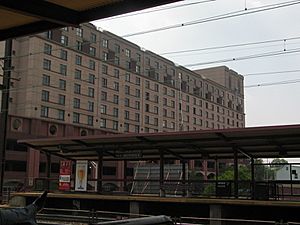
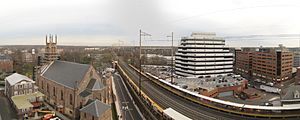
New Brunswick is served by NJ Transit and Amtrak trains on the Northeast Corridor Line. NJ Transit provides frequent service north to Pennsylvania Station, in Midtown Manhattan, and south to Trenton, while Amtrak's Keystone Service and Northeast Regional trains service the New Brunswick station. The Jersey Avenue station is also served by Northeast Corridor trains. For other Amtrak connections, riders can take NJ Transit to Penn Station (New York or Newark), Trenton, or Metropark.
Local bus service is provided by NJ Transit's 810, 811, 814, 815, 818 routes and 980 route.
Also available is the extensive Rutgers Campus bus network. Middlesex County Area Transit (MCAT) shuttles provide service on routes operating across the county, including the M1 route, which operates between Jamesburg and the New Brunswick train station. DASH/CAT buses, operated by Somerset County on the 851 and 852 routes connect New Brunswick and Bound Brook.
Suburban Trails offers service to and from New York City on Route 100 between Princeton and the Port Authority Bus Terminal; on Route 500 between New Brunswick and along 42nd Street to the United Nations; and Route 600 between East Windsor and Wall Street in Downtown Manhattan. Studies are being conducted to create the New Brunswick Bus Rapid Transit system.
Intercity bus service from New Brunswick to Columbia, Maryland, and Washington, D.C., is offered by OurBus Prime.
New Brunswick was at the eastern terminus of the Delaware and Raritan Canal, of which there are remnants surviving or rebuilt along the river. Until 1936, the city was served by the interurban Newark–Trenton Fast Line, which covered a 72-mile (116 km) route that stopped in New Brunswick as it ran between Jersey City and Trenton.
The Raritan River Railroad ran to New Brunswick, but is now defunct along this part of the line. The track and freight station still remain. Proposals have been made to use the line as a light rail route that would provide an option for commuters now driving in cars on Route 18.
Popular culture
- On April 18, 1872, at New Brunswick, William Cameron Coup developed the system of loading circus equipment and animals on railroad cars from one end and through the train, rather than from the sides. This system would be adopted by other railroad circuses and used through the golden age of railroad circuses and even by the Ringling shows today.
- The 1980s sitcom, Charles in Charge, was set in New Brunswick.
- The 2004 movie Harold and Kumar Go To White Castle revolves around Harold and Kumar's attempt to get to a White Castle restaurant and includes a stop in a fictionalized New Brunswick.
- A segment of an episode of Rescue 911 featured a young boy from New Brunswick who called 911 when he realized his mother had a brain hemorrhage.
Points of interest
- Albany Street Bridge across the Raritan River to Highland Park
- Bishop House, 115 College Avenue, a mansion of the Italianate style of architecture, was built for James Bishop. Placed on the National Register of Historic Places in 1976.
- Old Queens, built in 1809, is the oldest building at Rutgers University.
- Buccleuch Mansion in Buccleuch Park
- Historic Christ Church Episcopal Churchyard, New Brunswick
- The Henry Guest House
- William H. Johnson House c. 1870
- St. Peter The Apostle Church, built in 1856 and located at 94 Somerset Street.
- Delaware and Raritan Canal
- The historic Old Queens Campus and Voorhees Mall at Rutgers University
- Birthplace of poet Joyce Kilmer
- Kilmer Square, a retail/commercial complex on Albany Street
- Site of Johnson & Johnson world headquarters
- Rutgers Gardens (in nearby North Brunswick)
- The Willow Grove Cemetery near downtown
- Grave of Mary Ellis (1750–1828). This grave stands out due to its location in the AMC Theatres parking lot on U.S. Route 1 downriver from downtown New Brunswick.
- Lawrence Brook, a tributary of the Raritan River.
- Elmer B. Boyd Park, a park running along the Raritan River, adjacent to Route 18.
Places of worship
- Abundant Life Family Worship Church - founded in 1991.
- Anshe Emeth Memorial Temple (Reform Judaism) - established in 1859.
- Ascension Lutheran Church - founded in 1908 as The New Brunswick First Magyar Augsburg Evangelical Church.
- Christ Church, Episcopal - granted a royal charter in 1761.
- Ebenezer Baptist Church
- First Baptist Church of New Brunswick, American Baptist
- First Presbyterian, Presbyterian (PCUSA)
- First Reformed Reformed (RCA)
- Kirkpatrick Chapel at Rutgers University (nondenominational)
- Magyar Reformed, Calvinist
- Mount Zion AME (African Methodist Episcopal)
- Nativity of the Blessed Virgin Mary Ukrainian Catholic Church
- Point Community Church
- Saint Joseph, Byzantine Catholic
- Saint Ladislaus, Roman Catholic
- Saint Mary of Mount Virgin Church, Remsen Avenue and Sandford Street, Roman Catholic
- Sacred Heart Church, Throop Avenue, Roman Catholic
- Saint Peter the Apostle Church, Somerset Street, Roman Catholic
- Second Reformed Church, Reformed (RCA)
- Sharon Baptist Church
- United Methodist Church at New Brunswick
- Voorhees Chapel at Rutgers University (nondenominational)
Sister cities
New Brunswick has four sister cities, as listed by Sister Cities International:
 Debrecen, Hajdú-Bihar, Hungary
Debrecen, Hajdú-Bihar, Hungary Fukui City, Fukui, Japan
Fukui City, Fukui, Japan Limerick, County Limerick, Munster, Ireland
Limerick, County Limerick, Munster, Ireland Tsuruoka, Yamagata, Japan
Tsuruoka, Yamagata, Japan
- New Brunswick Public Schools's 2014–15 School Report Card from the New Jersey Department of Education
 |
Piscataway Township Highland Park |
Edison Township |  |
|
| Franklin Township | ||||
| North Brunswick Township | East Brunswick Township |
Economy
Urban Enterprise Zone
Portions of the city are part of an Urban Enterprise Zone (UEZ), one of 32 zones covering 37 municipalities statewide. New Brunswick was selected in 2004 as one of two zones added to participate in the program. In addition to other benefits to encourage employment and investment within the Zone, shoppers can take advantage of a reduced 3.3125% sales tax rate (half of the 6+5⁄8% rate charged statewide) at eligible merchants. Established in December 2004, the city's Urban Enterprise Zone status expires in December 2024.
Education
Public schools
The New Brunswick Public Schools serve students in pre-kindergarten through twelfth grade. The district is one of 31 former Abbott districts statewide that were established pursuant to the decision by the New Jersey Supreme Court in Abbott v. Burke which are now referred to as "SDA Districts" based on the requirement for the state to cover all costs for school building and renovation projects in these districts under the supervision of the New Jersey Schools Development Authority. The district's nine-member Board of Education is elected at large, with three members up for election on a staggered basis each April to serve three-year terms of office; until 2012, the members of the Board of Education were appointed by the city's mayor.
As of the 2018–19 school year, the district, comprised of 11 schools, had an enrollment of 10,422 students and 781.8 classroom teachers (on an FTE basis), for a student–teacher ratio of 13.3:1. Schools in the district (with 2018–19 enrollment data from the National Center for Education Statistics) are Lincoln Annex School (747 students; in grade 4–8), Lincoln Elementary School (544; K-3), Livingston Elementary School (434; K-5), Lord Stirling Elementary School (560; PreK-5), McKinley Community Elementary School (761; PreK-8), A. Chester Redshaw Elementary School (1,012; PreK-5), Paul Robeson Community School For The Arts (665; K-8), Roosevelt Elementary School (733; K-5), Woodrow Wilson Elementary School (416; PreK-8), New Brunswick Middle School (1,167; 6–8), New Brunswick High School (2,206; 9–12), New Brunswick Health Sciences Technology High School (9-12; NA) and New Brunswick P-TECH
The community is also served by the Greater Brunswick Charter School, a K-8 charter school serving students from New Brunswick, Edison, Highland Park and Milltown. As of the 2017–18 school year, the school, had an enrollment of 395 students and 33.0 classroom teachers (on an FTE basis), for a student–teacher ratio of 12.0:1.
Eighth grade students from all of Middlesex County are eligible to apply to attend the high school programs offered by the Middlesex County Vocational and Technical Schools, a county-wide vocational school district that offers full-time career and technical education at Middlesex County Academy in Edison, the Academy for Allied Health and Biomedical Sciences in Woodbridge Township and at its East Brunswick, Perth Amboy and Piscataway technical high schools, with no tuition charged to students for attendance.
Higher education
- Rutgers University has three campuses in the city: College Avenue Campus (seat of the University), Douglass Campus, and Cook Campus, which extend into surrounding townships. Rutgers has also added several buildings downtown in the last two decades, both academic and residential.
- New Brunswick is the site to the New Brunswick Theological Seminary, a seminary of the Reformed Church in America, that was founded in New York in 1784, then moved to New Brunswick in 1810.
- Robert Wood Johnson Medical School, part of Rutgers University, is located in New Brunswick and Piscataway.
- Middlesex County College has some facilities downtown, though its main campus is in Edison.
Notable people
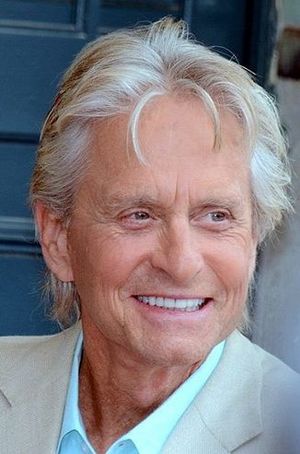
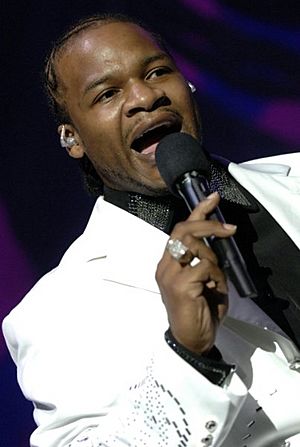

People who were born in, residents of, or otherwise closely associated with the City of New Brunswick include:
- David Abeel (1804–1846), Dutch Reformed Church missionary.
- Hallie Eisenberg (born 1992), actress.
- Garnett Adrain (1815–1878), member of the United States House of Representatives.
- Charlie Atherton (1874–1934), major league baseball player.
- Jim Axelrod, national correspondent for CBS News, and reports for the CBS Evening News.
- Catherine Hayes Bailey (1921–2014), plant geneticist who specialized in fruit breeding.
- Joe Barzda (1915–1993), race car driver.
- John Bayard (1738–1807), merchant, soldier and statesman who was a delegate for Pennsylvania to the Continental Congress in 1785 and 1786, and later mayor of New Brunswick.
- John Bradbury Bennet (1865–1940), United States Army officer and brigadier general active during World War I.
- James Berardinelli (born 1967), film critic.
- James Bishop (1816–1895), represented New Jersey's 3rd congressional district in the United States House of Representatives from 1855 to 1857.
- Charles S. Boggs (1811–1877), Rear Admiral who served in the United States Navy during the Mexican–American War and the American Civil War.
- PJ Bond, singer-songwriter.
- Jake Bornheimer (1927–1986), professional basketball player for the Philadelphia Warriors.
- James Bornheimer (1933–1993), politician who served in the New Jersey General Assembly from 1972 to 1982 and in the New Jersey Senate from 1982 to 1984.
- Brett Brackett (born 1987), football tight end.
- Derrick Drop Braxton (born 1981), record producer and composer.
- Sherry Britton (1918–2008), burlesque performer and actress.
- Gary Brokaw (born 1954), former professional basketball player who played most of his NBA career for the Milwaukee Bucks.
- Jalen Brunson (born 1996), basketball player.
- William Burdett-Coutts (1851–1921), British Conservative politician who sat in the House of Commons from 1885 to 1921.
- Darhyl Camper (born 1990), singer-songwriter and record producer.
- Arthur S. Carpender (1884–1960), United States Navy admiral who commanded the Allied Naval Forces in the Southwest Pacific Area during World War II.
- Jonathan Casillas (born 1987), linebacker for the NFL's New Orleans Saints and University of Wisconsin.
- Joseph Compton Castner (1869–1946), Army general
- Chris Dailey (born 1959), women's basketball coach, who has been the associate head coach for the Connecticut Huskies women's basketball team since 1988.
- Andre Dixon (born 1986), former professional football running back.
- Wheeler Winston Dixon (born 1950), filmmaker, critic and author.
- Michael Douglas (born 1944), actor.
- Linda Emond (born 1959), actress.
- Jerome Epstein (born 1937), politician who served in the New Jersey Senate from 1972 to 1974 and later went to federal prison for pirating millions of dollars worth of fuel oil.
- Anthony Walton White Evans (1817–1886), engineer.
- Robert Farmar (1717–1778), British Army officer who fought in the Seven Years' War and served as interim governor of British West Florida.
- Mervin Field (1921–2015), pollster of public opinion.
- Louis Michael Figueroa (born 1966), arguably the most prolific transcontinental journeyman.
- Charles Fiske (1868–1942), bishop of the Episcopal Diocese of Central New York from 1924 to 1936.
- Haley Fiske (1852–1929), lawyer who served as President of the Metropolitan Life Insurance Company.
- Margaret Kemble Gage (1734–1824). wife of General Thomas Gage, who led the British Army in Massachusetts early in the American Revolutionary War and who may have informed the revolutionaries of her husband's strategy.
- Morris Goodkind (c. 1888–1968), chief bridge engineer for the New Jersey State Highway Department from 1925 to 1955 (now the New Jersey Department of Transportation), responsible for the design of the Pulaski Skyway and 4,000 other bridges.
- Vera Mae Green (1928–1982), anthropologist, educator and scholar, who made major contributions in the fields of Caribbean studies, interethnic studies, black family studies and the study of poverty and the poor.
- Alan Guth (born 1947), theoretical physicist and cosmologist best known for his theory of cosmological inflation.
- Augustus A. Hardenbergh (1830–1889), represented New Jersey's 7th congressional district from 1875 to 1879, and again from 1881 to 1883.
- Mel Harris (born 1956), actress.
- Mark Helias (born 1950), jazz bassist / composer.
- Susan Hendricks (born 1973), anchor for HLN and substitute anchor for CNN.
- Laurie Hernandez (born 2000), artistic gymnast representing Team USA at the 2016 Summer Olympics.
- Sabah Homasi (born 1988), mixed martial artist who competes in the welterweight division.
- Christine Moore Howell (1899–1972), hair care product businesswoman who founded Christine Cosmetics.
- Adam Hyler (1735–1782), privateer during the American Revolutionary War.
- Bill Hynes (born 1972), professional auto racing driver and entrepreneur.
- Jaheim (born 1978, full name Jaheim Hoagland), R&B singer.
- Dwayne Jarrett (born 1986), wide receiver for the University of Southern California football team 2004 to 2006, current WR drafted by the Carolina Panthers.
- James P. Johnson (1891–1955), pianist and composer who was one of the original stride piano masters.
- William H. Johnson (1829–1904), painter and wallpaper hanger, businessman and local crafts person, whose home (c. 1870) was placed on the State of New Jersey and National Registers of Historic Places in 2006.
- Robert Wood Johnson I (1845–1910), businessman who was one of the founders of Johnson & Johnson.
- Robert Wood Johnson II (1893–1968), businessman who led Johnson & Johnson and served as mayor of Highland Park, New Jersey.
- Woody Johnson (born 1947), businessman, philanthropist, and diplomat who is currently serving as United States Ambassador to the United Kingdom.
- Mary Lea Johnson Richards (1926–1990), heiress, entrepreneur and Broadway producer, who was the first baby to appear on a Johnson's baby powder label.
- Frederick Barnett Kilmer (1851–1934), pharmacist, author, public health activist and the director of Scientific Laboratories for Johnson & Johnson from 1889 to 1934.
- Joyce Kilmer (1886–1918), poet.
- Littleton Kirkpatrick (1797–1859), represented New Jersey's 4th congressional district in the United States House of Representatives from 1853 to 1855, and was mayor of New Brunswick in 1841 and 1842.
- Ted Kubiak (born 1942), MLB player for the Kansas City/Oakland Athletics, Milwaukee Brewers, St. Louis Cardinals, Texas Rangers, and the San Diego Padres.
- Roy Mack (1889–1962), director of film shorts, mostly comedies, with 205 titles to his credit.
- Floyd Mayweather Jr. (born 1977), multi-division winning boxer, currently with an undefeated record of 50–0; he grew up in the 1980s in the Hiram Square neighborhood.
- Jim Norton (born 1968), comedian.
- Robert Pastorelli (1954–2004), actor known primarily for playing the role of the house painter on Murphy Brown.
- Judith Persichilli (born 1949), nurse and health care executive who has served as the Commissioner of the New Jersey Department of Health.
- Hasan Piker (born 1991), Twitch streamer and political commentator.
- Stephen Porges (born 1945), Professor in the Department of Psychiatry at the University of North Carolina at Chapel Hill.
- Franke Previte (born 1946), composer.
- Phil Radford (born 1976), Greenpeace Executive Director.
- Miles Ross (1827–1903), Mayor of New Brunswick, U.S. Representative and businessman.
- Mohamed Sanu (born 1989), American football wide receiver who has played in the NFL for the New England Patriots and San Francisco 49ers.
- Gabe Saporta (born 1979), musician and frontman of bands Midtown and Cobra Starship.
- Robert J. Sexton, writer and director
- Jeff Shaara (born 1952), historical novelist.
- Dustin Sheppard (born 1980), retired professional soccer player who played in MLS for the MetroStars.
- Brian D. Sicknick (1978–2021), officer of the United States Capitol Police who died following the 2021 storming of the United States Capitol.
- George Sebastian Silzer (1870–1940), served as the 38th Governor of New Jersey. Served on the New Brunswick board of aldermen from 1892 to 1896.
- James H. Simpson (1813–1883), U.S. Army surveyor of western frontier areas.
- Robert Sklar (1936–2011), historian and author specializing in the history of film.
- Arthur Space (1908–1983), actor of theatre, film, and television.
- Larry Stark (born 1932), theater reviewer and creator of Theater Mirror.
- Matt Taibbi (born 1970), author and journalist.
- Norman Tanzman (1918–2004), politician who served in the New Jersey General Assembly from 1962 to 1968 and in the New Jersey Senate from 1968 to 1974.
- Ron "Bumblefoot" Thal (born 1969), guitarist, musician, composer.
- Joe Theismann (born 1949), former professional quarterback who played in the NFL for the Washington Redskins and former commentator on ESPN's Monday Night Football.
- William Henry Vanderbilt (1821–1885), businessman.
- John Van Dyke (1807–1878), represented New Jersey's 4th congressional district in the United States House of Representatives from 1847 to 1851, and served as Mayor of New Brunswick from 1846 to 1847.
- Tony Vega (1961–2013), Thoroughbred horse jockey and community activist.
- Paul Wesley (born 1982), actor, known for his role as "Stefan Salvatore" on The CW show The Vampire Diaries.
- Rev. Samuel Merrill Woodbridge (1819–1905), minister, author, professor at Rutgers College and New Brunswick Theological Seminary.
- Eric Young (born 1967), former Major League Baseball player.
- Eric Young Jr. (born 1985), Major League Baseball player.
- All members of The Gaslight Anthem
- All members of Streetlight Manifesto
- All members of the Bouncing Souls
- All members of Thursday (band)
Images for kids
-
Old Queens, the oldest building at Rutgers University
See also
 In Spanish: Nuevo Brunswick (Nueva Jersey) para niños
In Spanish: Nuevo Brunswick (Nueva Jersey) para niños


